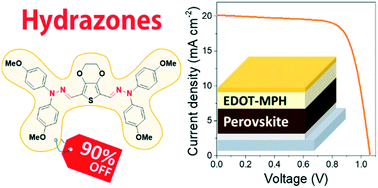Hydrazone-based hole transporting material prepared via condensation chemistry as alternative for cross-coupling chemistry for perovskite solar cells†
Abstract
Perovskite solar cells have shown an exceptionally fast increase in performance. So far, most high performing devices comprise expensive hole transport material (HTM) which are synthesized using tedious synthetic procedures, resulting in a high cost and thereby limit the potential use in large-scale applications. In a quest to find low-cost chemistry to link the building blocks, we explore hydrazone-based small molecules in this work. These materials can be synthesized in a simple condensation reaction, with water being the only side product leading to a low material cost of less than $10 per g. When used as hole transporting layers in perovskite solar cells, highly reproducible performance was obtained, similar to state-of-the-art materials, with the main difference being a small open-circuit voltage loss due to increased interfacial recombination. Thus, we show that hydrazone-based materials have the potential to compete in performance with materials obtained via cross-coupling reactions at a fraction of their cost.

- This article is part of the themed collection: Perovskite Based Optoelectronics: Molecular Design Perspectives


 Please wait while we load your content...
Please wait while we load your content...